
Colonial Puebla
The renowned panaderia in San Miguel de Allende, Mexico, is eponymously called the Blue Door. It’s breads and pastries are famous, as are the aroma of fresh bread and lines of hungry people out the door and down the block most mornings.
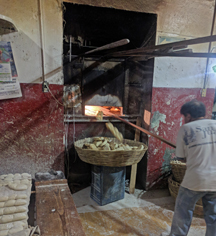 In Puebla, roughly 200 klicks southeast of San Miguel, El Hornito del San Francisco sports only graffiti-clad glass and iron doors, crowned by the motto “El traditional pan de Puebla desde 1965”—but has the same waft of aroma and line of customers up the street. A few footsteps down from the bedecked entrance to this temple of bread are scratched wooden doors that open onto a hive of activity. A long tin-clad worktable sits in the middle of the room, 20 kilo sacks of flour are strewn everywhere, and white clad, flour-dusted bakers mill around. At the end of the room sits a stone shelf that is the lower frame of an opening maybe three feet wide and ten inches tall that leads into an enormous brick oven, the interior of which must be 20 feet wide and go back 30-40 feet deep—the opening radiates waves of heat.
In Puebla, roughly 200 klicks southeast of San Miguel, El Hornito del San Francisco sports only graffiti-clad glass and iron doors, crowned by the motto “El traditional pan de Puebla desde 1965”—but has the same waft of aroma and line of customers up the street. A few footsteps down from the bedecked entrance to this temple of bread are scratched wooden doors that open onto a hive of activity. A long tin-clad worktable sits in the middle of the room, 20 kilo sacks of flour are strewn everywhere, and white clad, flour-dusted bakers mill around. At the end of the room sits a stone shelf that is the lower frame of an opening maybe three feet wide and ten inches tall that leads into an enormous brick oven, the interior of which must be 20 feet wide and go back 30-40 feet deep—the opening radiates waves of heat.
On the floor below the oven opening is a stack of wide, shallow round baskets to receive fresh bollilos, and outside the scratched door are a couple of rickety bicycles with a wirerack in back of the seat, sized just to hold those round baskets, as well as a group of lounging youths ready to send the bread to its destiny around the city.
As we watch, a muscular forearmed baker with a long-handled peel reaches deep into the horno and scoops 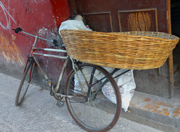 out dozens of perfectly golden oval rolls at a time and drops them directly down into the top basket on the stack. A helper whisks the basket to the door, into the arms of a bicycle delivery lad, who clips it to the frame, and off he goes into the gathering dusk. We’ll see these careening bread bikes all over the centro in the coming days, delivering hot Puebla rolls.
out dozens of perfectly golden oval rolls at a time and drops them directly down into the top basket on the stack. A helper whisks the basket to the door, into the arms of a bicycle delivery lad, who clips it to the frame, and off he goes into the gathering dusk. We’ll see these careening bread bikes all over the centro in the coming days, delivering hot Puebla rolls.
There is a sweet little church, bright Barragan fuchsia in color—Capilla del Cireneo directly across the 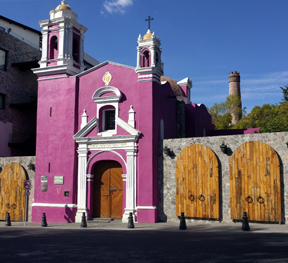 street......it’s rear nave nestles into the space out of which, along with several different historic and government buildings, the terraces, gardens, public rooms, guest rooms, courtyards and fountains of the recently opened Rosewood Hotel Puebla was created, and which is our home base for a few days exploring this colonial UNESCO world heritage site. As well as the Capilla, Los Lavaderos del Almoloya—a manual women’s laundry dating to 1863 and an office space Edificio Briseno have been fashioned into a lush and elegant compound of stone, brick, wrought iron, re-purposed steel and trees, shrubs and flowers housing the 78 rooms of the luxe hotel.
street......it’s rear nave nestles into the space out of which, along with several different historic and government buildings, the terraces, gardens, public rooms, guest rooms, courtyards and fountains of the recently opened Rosewood Hotel Puebla was created, and which is our home base for a few days exploring this colonial UNESCO world heritage site. As well as the Capilla, Los Lavaderos del Almoloya—a manual women’s laundry dating to 1863 and an office space Edificio Briseno have been fashioned into a lush and elegant compound of stone, brick, wrought iron, re-purposed steel and trees, shrubs and flowers housing the 78 rooms of the luxe hotel.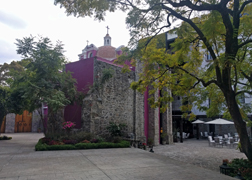
The lobby is soaring and elegant, with iron and glass windows facing the central courtyards. There is a glass wall behind reception looking down on the Bar Los Lavadores, and just behind that, the unique long subterranean room with twin ranks of 20 carved stone wash basins with a central water channel served by the Almoloya spring (Almoloya is said to mean “water that flows in Aztec). Los Lavadores de Almoloya was constructed in 1863 on the site of older laundries going back 150 years. Laundry was the task of women of low social class, and at work,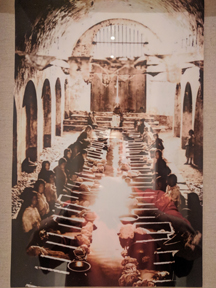 these laundresses traded confidences and gossip about the noble and rich families they worked for. The washerwoman hung their laundry to dry at the rear of the Capilla de Cierneo, now part of the main hotel courtyard. Los Lavadores finally closed in 1980 and derelict until Rosewood commenced renovation of the area. Tours of Los Lavadores are available to hotel guests.
these laundresses traded confidences and gossip about the noble and rich families they worked for. The washerwoman hung their laundry to dry at the rear of the Capilla de Cierneo, now part of the main hotel courtyard. Los Lavadores finally closed in 1980 and derelict until Rosewood commenced renovation of the area. Tours of Los Lavadores are available to hotel guests.
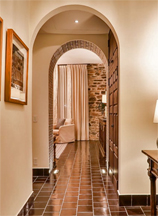 Our room is on the second floor of the building set behind the courtyard and the small Capilla. Dark, sleek Talavera tile floors, white stucco walls with partially exposed stone, and aged oak beams set the tone. There is lots of space, and a view out onto a private cactus garden, overlooked by the salmon bell towers of the Paroqueria Santa Cruz, as well as rear windows looking onto the pink Mercato Alto. Carved wood paneled closet and bathroom doors lead to a large, luxurious marble bathroom, with both glass shower, and hammered pewter tub and a wall of blue azulejo tiles. The furniture is colonial baroque, and the downside is seating....there is a corner built in unit, tufted and rigidly upright, impossible to sit in and relax and read....why hotel designers can’t focus first on comfort is far beyond me, but it’s way too common of a circumstance.
Our room is on the second floor of the building set behind the courtyard and the small Capilla. Dark, sleek Talavera tile floors, white stucco walls with partially exposed stone, and aged oak beams set the tone. There is lots of space, and a view out onto a private cactus garden, overlooked by the salmon bell towers of the Paroqueria Santa Cruz, as well as rear windows looking onto the pink Mercato Alto. Carved wood paneled closet and bathroom doors lead to a large, luxurious marble bathroom, with both glass shower, and hammered pewter tub and a wall of blue azulejo tiles. The furniture is colonial baroque, and the downside is seating....there is a corner built in unit, tufted and rigidly upright, impossible to sit in and relax and read....why hotel designers can’t focus first on comfort is far beyond me, but it’s way too common of a circumstance.
The panoramic view of the city with the gently venting volcano Popocatepetl and its snow-capped companion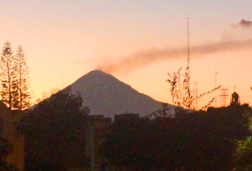 Iztaccihuatl is spectacular from the 5th floor roof deck bar of the hotel. There are said to be close to 500 churches in Puebla, from the austere to the opulent. The multi-hued glazed and red tiled domes, a Moorish mosque, ochre, marigold, and deep violets twin bell towers and steeples of many are visible across the sweep of the skyline. It’s not unlike the view out over the roofs of Florence. The Rosewood has a well-appointed fitness center, the rooftop pool, and the spa, Sense, for the normal luxury hotel pampering. As well as the rooftop view bar, and Bar Lavadores, there is a lovely little four stool bar in the entry of Pasquinale Restaurant.
Iztaccihuatl is spectacular from the 5th floor roof deck bar of the hotel. There are said to be close to 500 churches in Puebla, from the austere to the opulent. The multi-hued glazed and red tiled domes, a Moorish mosque, ochre, marigold, and deep violets twin bell towers and steeples of many are visible across the sweep of the skyline. It’s not unlike the view out over the roofs of Florence. The Rosewood has a well-appointed fitness center, the rooftop pool, and the spa, Sense, for the normal luxury hotel pampering. As well as the rooftop view bar, and Bar Lavadores, there is a lovely little four stool bar in the entry of Pasquinale Restaurant.
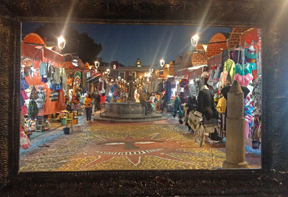 After admiring the view with a perfect margarita crafted by Luis, we head into town for an initial reconnoiter. Rosewood Puebla is a bit past the edge of the main historic center, so a bit of perambulating is in order. We wander down to the Barrio des Artistes, with regular arched brick canopies over shops and galleries displaying all manner of original art. That leads to the open-air Mercado el Parian, with textiles, ceramics and hand crafts from all over Mexico, and then we turn west up Avendida 2 Oriente, through block after block of preserved colonial architecture and thence to the zocalo at the center of town.
After admiring the view with a perfect margarita crafted by Luis, we head into town for an initial reconnoiter. Rosewood Puebla is a bit past the edge of the main historic center, so a bit of perambulating is in order. We wander down to the Barrio des Artistes, with regular arched brick canopies over shops and galleries displaying all manner of original art. That leads to the open-air Mercado el Parian, with textiles, ceramics and hand crafts from all over Mexico, and then we turn west up Avendida 2 Oriente, through block after block of preserved colonial architecture and thence to the zocalo at the center of town.
Puebla was founded in 1531 by the Spanish Viceroyalty as Puebla de los Angeles (City of Angels). One of the first cities in Latin America, it occupied a strategic location between Mexico City and the Port of Veracruz, and was the main focus of economic, social and political development of the southern highlands region. The city was developed in a planned fashion as a grid, with the Zocalo and the imposing dark granite Cathedral at its heart. The Centro Historic is a 10 by 10 block cobbled-street preserved colonial showcase that was named a UNESCO World Heritage Site in 1987. Carved stone edifices abound, with wrought iron balconies and many buildings are frosted in the local Talavera ceramic tile.
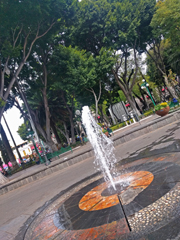 The Zocalo, filled with tall trees, fountains and gardens—Puebla’s living room—is surrounded by stately historical and government buildings, including the Ayunamiento, or city hall and three sets of colonnaded arcades known as Portales—Portal Hidalgo, Portal Iturbide and Portal Morelos. On the south side of the Zocalo sits Puebla Cathedral, one of the most imposing churches In Mexico. We circumnavigate the Portals people watching the throng of Christmas Eve revelers: young girls taking selfies with three costumed Magi, a small boy gaping at a green Christmas grinch, vendors with huge bunches of brightly colored balloons, and various street musicians, all plying holiday tunes.
The Zocalo, filled with tall trees, fountains and gardens—Puebla’s living room—is surrounded by stately historical and government buildings, including the Ayunamiento, or city hall and three sets of colonnaded arcades known as Portales—Portal Hidalgo, Portal Iturbide and Portal Morelos. On the south side of the Zocalo sits Puebla Cathedral, one of the most imposing churches In Mexico. We circumnavigate the Portals people watching the throng of Christmas Eve revelers: young girls taking selfies with three costumed Magi, a small boy gaping at a green Christmas grinch, vendors with huge bunches of brightly colored balloons, and various street musicians, all plying holiday tunes.
The Cathedral, a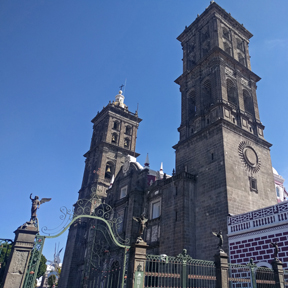 glory of colonial architecture and artwork, was designed by Francisco Becerra, and construction commenced in 1575. Expansion was overseen by Bishop Juan de Palafox y Mendoza, who consecrated the cathedral in 1649. The design is mainly Baroque and Neoclassical. The exterior roof features a series of red domes.
glory of colonial architecture and artwork, was designed by Francisco Becerra, and construction commenced in 1575. Expansion was overseen by Bishop Juan de Palafox y Mendoza, who consecrated the cathedral in 1649. The design is mainly Baroque and Neoclassical. The exterior roof features a series of red domes.
Local legend says that the daunting engineering problem of installing the 8.5-ton bell in the 200 foot high tower was miraculously solved when angels took over to help the builders. Overnight, it is said, angels raised the bell and set it in the tower.
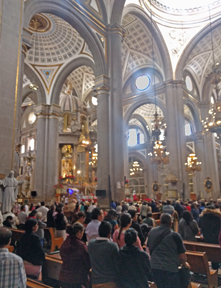 We enter and take one of a few empty pews at the rear, just as mass is ending, with the chorus singing Christmas carols. After the service, we circumnavigate the interior, which has 14 side chapels and a splendid main altar depicting the kings and queens of 17th-century Europe. The choir is a nice specimen of Mudejar artwork with inlaid wood of eight different varieties.
We enter and take one of a few empty pews at the rear, just as mass is ending, with the chorus singing Christmas carols. After the service, we circumnavigate the interior, which has 14 side chapels and a splendid main altar depicting the kings and queens of 17th-century Europe. The choir is a nice specimen of Mudejar artwork with inlaid wood of eight different varieties.
We taxi back to the Rosewood ($2.50) and discuss specialty cocktails with the young duty bartender, Ivan. We’re attuned to the classics, and the F & B manager, Jorge, who hails from Spain, recommends martinis made with Mexican Oliver gin....and they are smooth and bracing......we’ll try the fancy stuff later. We’ve booked for Christmas Eve dinner at the hotel’s top restaurant, Bistro Pasquinele, and are seated at a corner table surrounded mostly by Mexican families. Service is terrific and friendly, and restaurant manager Jose Luis discusses the wine list, and recommends a Casa Madero 3V—meaning three vines—cabernet, merlot and tempranillo. Casa Madero is in fact the oldest winery in Latin America, with vineyards originally planted in 1597. Dinner commences with a lovely composed Caesar salad, esquites of corn, and then moves on to either lechon—confit of suckling pig, or veal osso bucco—both delicious. It’s a very festive Christmas Eve atmosphere—this being the big celebration evening for Mexican families.
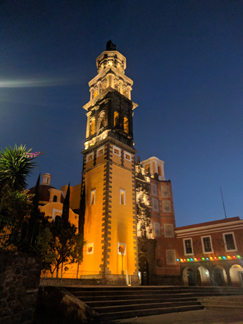 Luggage, lost in a re-routed flight down, finally arrived after three days (thanks, United) so finally with fresh clothes, we set out on a beautiful Boxing Day morn to explore the centro.We first meander past nearby Templo de San Francisco de Asis church with its fantastic tile facade, and around the Barrio del Alto which has undergone much civic improvement and renovation in the last few years. There is a manicured park, Paseo del San Francisco, and we drift into the recently converted upscale Hotel Purificadora for an overview inspection, and then make a stop for Margaritas and botanos at hotel Casareyna Puebla. We stroll through the still-working-class byways and to the bright pink Mercado El Alto, which we see from our Rosewood room, filled with food stalls and small restaurants offering traditional Puebla foods, including mole poblano—said to be invented in Puebla, molotes, chanclas, cemitas and more.
Luggage, lost in a re-routed flight down, finally arrived after three days (thanks, United) so finally with fresh clothes, we set out on a beautiful Boxing Day morn to explore the centro.We first meander past nearby Templo de San Francisco de Asis church with its fantastic tile facade, and around the Barrio del Alto which has undergone much civic improvement and renovation in the last few years. There is a manicured park, Paseo del San Francisco, and we drift into the recently converted upscale Hotel Purificadora for an overview inspection, and then make a stop for Margaritas and botanos at hotel Casareyna Puebla. We stroll through the still-working-class byways and to the bright pink Mercado El Alto, which we see from our Rosewood room, filled with food stalls and small restaurants offering traditional Puebla foods, including mole poblano—said to be invented in Puebla, molotes, chanclas, cemitas and more.
Uriarte is one of the two big Talavera producers, and they have a 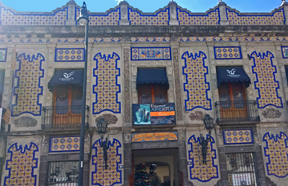 shop and demonstration workshop at Ave. 4 Potiente...the front of which is completely covered in intricate, colorful tiles. Unfortunately, the demonstrations of ceramic work are on holiday hiatus, but the shop is full of lovely pottery to browse, and there is a separate section dedicated to high art pieces that were done by known ceramicists for the 150th celebration of Cinco de Mayo in 2012. Right across the street is the Mercado de Sabores, a huge local food hall, but we’re on the early side of lunch. A half dozen blocks away we pass through the 1800’s wrought iron Mercado Valencia, and a bit further, two blocks of Ave. 6 Oriente, also known as Calle de Los Dulces, make up the confectioner’s zone—shop after shop offers some of Puebla's most iconic sweets, including camotes (cigar-shaped rolls of coconut), salted caramels, candied citrus rinds and small round cookies with a marzipan-like glaze called tortitas de Santa Clara, originated by the Santa Clara nuns.
shop and demonstration workshop at Ave. 4 Potiente...the front of which is completely covered in intricate, colorful tiles. Unfortunately, the demonstrations of ceramic work are on holiday hiatus, but the shop is full of lovely pottery to browse, and there is a separate section dedicated to high art pieces that were done by known ceramicists for the 150th celebration of Cinco de Mayo in 2012. Right across the street is the Mercado de Sabores, a huge local food hall, but we’re on the early side of lunch. A half dozen blocks away we pass through the 1800’s wrought iron Mercado Valencia, and a bit further, two blocks of Ave. 6 Oriente, also known as Calle de Los Dulces, make up the confectioner’s zone—shop after shop offers some of Puebla's most iconic sweets, including camotes (cigar-shaped rolls of coconut), salted caramels, candied citrus rinds and small round cookies with a marzipan-like glaze called tortitas de Santa Clara, originated by the Santa Clara nuns.
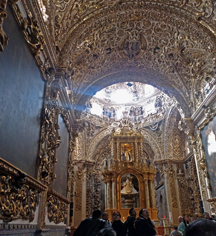 Around the corner we enter the Templo de Santo Domingo de Guzman. The Dominicans arrived in Puebla in the late 1700’s and built a convent and commenced the Santo Domingo church. Inside the church, the main attraction is the Rosario Chapel, a masterpiece of Puebla Baroque architecture, completed in 1690 after almost 40 years of construction. The amount of gold is staggering (reminiscent of Sao Francisco church in Porto). What’s not covered in arabesques and curlicues of gold is adorned in Talavera tile, painted panels, marble and onyx. With sunlight streaming in from the cupola, it practically vibrates.
Around the corner we enter the Templo de Santo Domingo de Guzman. The Dominicans arrived in Puebla in the late 1700’s and built a convent and commenced the Santo Domingo church. Inside the church, the main attraction is the Rosario Chapel, a masterpiece of Puebla Baroque architecture, completed in 1690 after almost 40 years of construction. The amount of gold is staggering (reminiscent of Sao Francisco church in Porto). What’s not covered in arabesques and curlicues of gold is adorned in Talavera tile, painted panels, marble and onyx. With sunlight streaming in from the cupola, it practically vibrates.
Back into the sunlight, down the pedestrian Calle de Cinco de Mayo, past a gnarled street saxophonist and a lone organ-grinder, to the zocalo. South of the Cathedral is the commanding Palacio Arzobispal, clad in herringbone brick and tile. We reach the Centro Culturale, head through the courtyard and up the stone stairs to the Biblioteca Palafoxiana—the first public library in the Americas—named for that same archbishop who consecrated the cathedral. One enters an ornate tile entryway into a stunning long wood paneled and carved three-tier vaulted-ceiling room, where wire mesh-fronted bookshelves contain over 5,000 volumes dating back 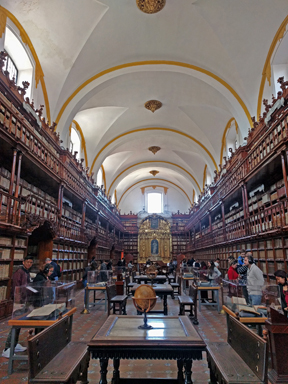 to the 1400’s. Archbishop Palafox donated his collection with the proviso they be made available to the public. There is an interesting device that looks like a water wheel, with gearing so that several books can be placed on the various shelves, and the wheel turned up and down with the books always facing up. It’s a glorious space, and reminiscent of the Long Library at Trinity College, Dublin, and the Cuypers Library at the Rijksmuseum.
to the 1400’s. Archbishop Palafox donated his collection with the proviso they be made available to the public. There is an interesting device that looks like a water wheel, with gearing so that several books can be placed on the various shelves, and the wheel turned up and down with the books always facing up. It’s a glorious space, and reminiscent of the Long Library at Trinity College, Dublin, and the Cuypers Library at the Rijksmuseum.
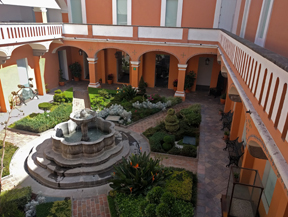 Two blocks further we come to one of the art centers of Puebla, the Museo Amparo, set in a pair of 17th and 18th century buildings that have been completely modernized inside, with a large skylit entry courtyard. The museum contains a permanent collection of thousands of pre-hispanic pieces, and another permanent collection more interesting to us of contemporary art including pieces from famous artists such as Frida Kahlo, Diego Rivera, Vicente Rojo and Manuel Felguérez. The current temporary exhibitions include a display by artist Yves Klein called Pigmento Puro, which features a huge field of intense blue on the floor of the entry courtyard, and posters and other graphics from the 1968 student demonstrations in Mexico City.
Two blocks further we come to one of the art centers of Puebla, the Museo Amparo, set in a pair of 17th and 18th century buildings that have been completely modernized inside, with a large skylit entry courtyard. The museum contains a permanent collection of thousands of pre-hispanic pieces, and another permanent collection more interesting to us of contemporary art including pieces from famous artists such as Frida Kahlo, Diego Rivera, Vicente Rojo and Manuel Felguérez. The current temporary exhibitions include a display by artist Yves Klein called Pigmento Puro, which features a huge field of intense blue on the floor of the entry courtyard, and posters and other graphics from the 1968 student demonstrations in Mexico City.
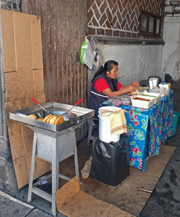 Street food is everywhere in Puebla. Small wizened women frying molotes—filled masa and potato dough—in a copper pot of lard; tacos ricos griddled on an open comal by a smiling gold-toothed fellow; quesadillas—thick, oblong blue-corn tortillas filled with stringy white cheese, bright zucchini blossoms and mushrooms; cemitas, a small crunchy roll filled with quesilla, avocado, and perhaps carne al pastor; tasty chalupas...tiny fried tortillas topped with salsa verde or rojo and shredded pork or chicken; memelas—really a variation
Street food is everywhere in Puebla. Small wizened women frying molotes—filled masa and potato dough—in a copper pot of lard; tacos ricos griddled on an open comal by a smiling gold-toothed fellow; quesadillas—thick, oblong blue-corn tortillas filled with stringy white cheese, bright zucchini blossoms and mushrooms; cemitas, a small crunchy roll filled with quesilla, avocado, and perhaps carne al pastor; tasty chalupas...tiny fried tortillas topped with salsa verde or rojo and shredded pork or chicken; memelas—really a variation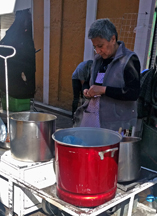 on a tostada; and tacos árabes (arab-style taco) which is made with pork layered with onions and herbs grilled on a vertical spit and served in a pan arabe—pretty close to pita bread. At one of the latter stands, 150 pesos buys a kilo of meat of choice, 10 pan arabes and 20 corn tortillas.
on a tostada; and tacos árabes (arab-style taco) which is made with pork layered with onions and herbs grilled on a vertical spit and served in a pan arabe—pretty close to pita bread. At one of the latter stands, 150 pesos buys a kilo of meat of choice, 10 pan arabes and 20 corn tortillas.
We sample a molote and memela as a pickup l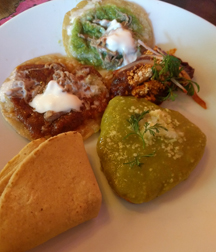 unch, and back at the Rosewood to prepare for departure, our final dinner is in fact street food. Since the restaurant is far from busy, we're told we can order from any of the other restaurant menus, so we choose guacamole and chips to go with a shot of Siete Leguas reposado tequila and Noche Buena, the bock beer only brewed around Christmas, and what the locals refer to as Mexica pizza—tlayuda—a huge, thin crispy corn tortilla covered in stringy cheese, mushrooms and grilled chicken. guacamole.
unch, and back at the Rosewood to prepare for departure, our final dinner is in fact street food. Since the restaurant is far from busy, we're told we can order from any of the other restaurant menus, so we choose guacamole and chips to go with a shot of Siete Leguas reposado tequila and Noche Buena, the bock beer only brewed around Christmas, and what the locals refer to as Mexica pizza—tlayuda—a huge, thin crispy corn tortilla covered in stringy cheese, mushrooms and grilled chicken. guacamole.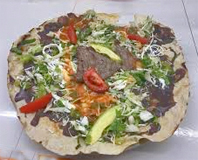 Finally, we'd heard about the local hangover remedy from Ivan the barman, and decide to try in advance La Piedra—the stone—which combines three parts white tequila, one part annisette and one part Fernet Branca—I guess in the morning we'll have a sense of its effectiveness, as we head down the road to Oaxaca.
Finally, we'd heard about the local hangover remedy from Ivan the barman, and decide to try in advance La Piedra—the stone—which combines three parts white tequila, one part annisette and one part Fernet Branca—I guess in the morning we'll have a sense of its effectiveness, as we head down the road to Oaxaca.
Rosewood Puebla
10 Norte #1402, Col. Barrio del Alto, Puebla, Puebla CP 72000 Mexico
T:+52 222 122 2300
E:puebla@rosewoodhotels.com